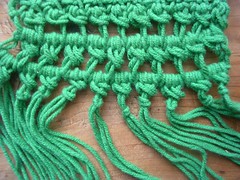
A stitch from S.F.A. Caulfeild's Dictionary of Needlework, pp. 128-129, rewritten in modern terms.
Abbreviations:
- YO = Yarn Over
- TSS = Tunisian Simple Stitch
- st(s) = stitch, or stitches
Chain a multiple of 3 stitches, plus 1.
1: Sk 1 chain. *YO. Pick up one st in each of the next 3 chains. Pinch the YO in the hand not holding the hook and pull the last three sts on the hook through the YO. (This leaves the three sts on the hook.)* Return as usual.
2: Skip the first vertical bar. *YO. 3 TSS. Pull the last 3 sts on the hook through the YO.* Return as usual.
This is very similar to some maneuvers from knitting, like passing a slipped stitch over another one.
(I expect the name has very little to do with the stitch's national origin - the name means Scottish knitting in French.)
